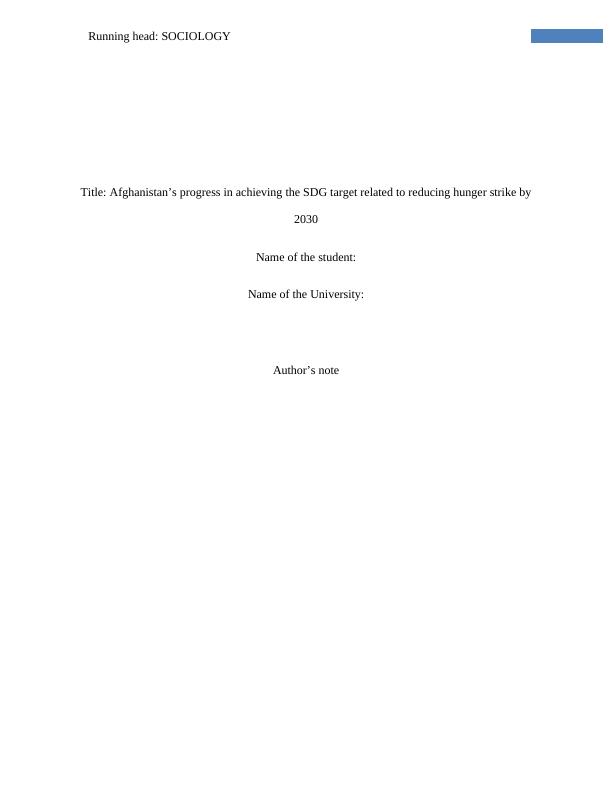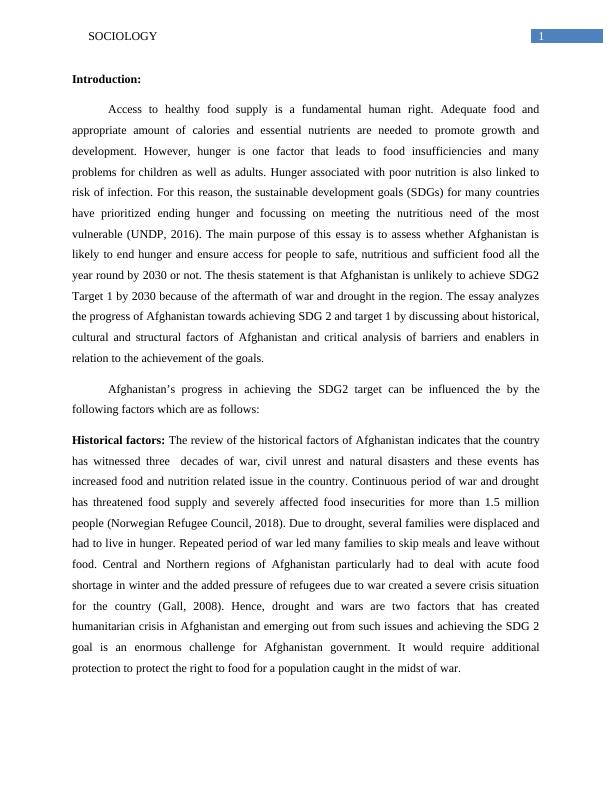Afghanistan’s Progress in Achieving SDG2 Target
Added on 2023-04-07
8 Pages2014 Words251 Views
Running head: SOCIOLOGY
Title: Afghanistan’s progress in achieving the SDG target related to reducing hunger strike by
2030
Name of the student:
Name of the University:
Author’s note
Title: Afghanistan’s progress in achieving the SDG target related to reducing hunger strike by
2030
Name of the student:
Name of the University:
Author’s note

1SOCIOLOGY
Introduction:
Access to healthy food supply is a fundamental human right. Adequate food and
appropriate amount of calories and essential nutrients are needed to promote growth and
development. However, hunger is one factor that leads to food insufficiencies and many
problems for children as well as adults. Hunger associated with poor nutrition is also linked to
risk of infection. For this reason, the sustainable development goals (SDGs) for many countries
have prioritized ending hunger and focussing on meeting the nutritious need of the most
vulnerable (UNDP, 2016). The main purpose of this essay is to assess whether Afghanistan is
likely to end hunger and ensure access for people to safe, nutritious and sufficient food all the
year round by 2030 or not. The thesis statement is that Afghanistan is unlikely to achieve SDG2
Target 1 by 2030 because of the aftermath of war and drought in the region. The essay analyzes
the progress of Afghanistan towards achieving SDG 2 and target 1 by discussing about historical,
cultural and structural factors of Afghanistan and critical analysis of barriers and enablers in
relation to the achievement of the goals.
Afghanistan’s progress in achieving the SDG2 target can be influenced the by the
following factors which are as follows:
Historical factors: The review of the historical factors of Afghanistan indicates that the country
has witnessed three decades of war, civil unrest and natural disasters and these events has
increased food and nutrition related issue in the country. Continuous period of war and drought
has threatened food supply and severely affected food insecurities for more than 1.5 million
people (Norwegian Refugee Council, 2018). Due to drought, several families were displaced and
had to live in hunger. Repeated period of war led many families to skip meals and leave without
food. Central and Northern regions of Afghanistan particularly had to deal with acute food
shortage in winter and the added pressure of refugees due to war created a severe crisis situation
for the country (Gall, 2008). Hence, drought and wars are two factors that has created
humanitarian crisis in Afghanistan and emerging out from such issues and achieving the SDG 2
goal is an enormous challenge for Afghanistan government. It would require additional
protection to protect the right to food for a population caught in the midst of war.
Introduction:
Access to healthy food supply is a fundamental human right. Adequate food and
appropriate amount of calories and essential nutrients are needed to promote growth and
development. However, hunger is one factor that leads to food insufficiencies and many
problems for children as well as adults. Hunger associated with poor nutrition is also linked to
risk of infection. For this reason, the sustainable development goals (SDGs) for many countries
have prioritized ending hunger and focussing on meeting the nutritious need of the most
vulnerable (UNDP, 2016). The main purpose of this essay is to assess whether Afghanistan is
likely to end hunger and ensure access for people to safe, nutritious and sufficient food all the
year round by 2030 or not. The thesis statement is that Afghanistan is unlikely to achieve SDG2
Target 1 by 2030 because of the aftermath of war and drought in the region. The essay analyzes
the progress of Afghanistan towards achieving SDG 2 and target 1 by discussing about historical,
cultural and structural factors of Afghanistan and critical analysis of barriers and enablers in
relation to the achievement of the goals.
Afghanistan’s progress in achieving the SDG2 target can be influenced the by the
following factors which are as follows:
Historical factors: The review of the historical factors of Afghanistan indicates that the country
has witnessed three decades of war, civil unrest and natural disasters and these events has
increased food and nutrition related issue in the country. Continuous period of war and drought
has threatened food supply and severely affected food insecurities for more than 1.5 million
people (Norwegian Refugee Council, 2018). Due to drought, several families were displaced and
had to live in hunger. Repeated period of war led many families to skip meals and leave without
food. Central and Northern regions of Afghanistan particularly had to deal with acute food
shortage in winter and the added pressure of refugees due to war created a severe crisis situation
for the country (Gall, 2008). Hence, drought and wars are two factors that has created
humanitarian crisis in Afghanistan and emerging out from such issues and achieving the SDG 2
goal is an enormous challenge for Afghanistan government. It would require additional
protection to protect the right to food for a population caught in the midst of war.

2SOCIOLOGY
Cultural factors: Cultural norms are one factor that increases risk of discriminatory practice
while planning to end hunger in Afghanistan. Several food aid programmes has been
implemented in villages like Bagdah and Kas so that food aid reaches the poorest families.
Though the government of Afghanistan has committed to achieving SDG goal 2 (Zero hunger),
however the country faces numerous challenges in meeting the target because of gender
disparities. During the Taliban rule, the women were subjected to many atrocities and they were
not allowed to move freely. Because of cultural norms, they were married off in younger age
than 15 and they lacked education on properly meeting nutritional needs of their children
(Walton, 2016). Hence, as the right to education and right to work for women have been
influenced by gender disparities in Afghanistan, the regional cultural norm will act as a major
barrier in the involvement of women in agricultural processes and addressing food supply issues.
Low level of women engagement in education and employment will also undermine efforts to
improve nutritional needs of family (Arsala, 2016).
Structural factors:
Apart from historical and cultural factors, several other factors like transport,
infrastructure, land and rural/urban gap can affect the capability of Afghanistan government to
meet SDG2 target. This is said because food access is significantly affected in the country
because of poor condition of roads in Afghanistan. Majority of the roads in Afghanistan are in
poor condition that can affect food transportation process. The situation is exacerbated by
climate related and conflict related disturbances (Arsala, 2016). Hence, because of poor roads,
food is unlikely to reach the market and high food price can further make achievement of SDG 2
goal difficult for Afghanistan. Rural infrastructures needed for food transport such as electricity,
post harvest storage infrastructure, cold storage facilities and other facilities are also poor in
Afghanistan. Furthermore, poor economy and employment can further increase challenges for
citizens as meeting food and nutritional needs would become difficult (D’Souza & Jolliffe,
2016). Hence, many structural factors present in Afghanistan will halt the progress towards
SDG2 goals.
Critical analysis:
Cultural factors: Cultural norms are one factor that increases risk of discriminatory practice
while planning to end hunger in Afghanistan. Several food aid programmes has been
implemented in villages like Bagdah and Kas so that food aid reaches the poorest families.
Though the government of Afghanistan has committed to achieving SDG goal 2 (Zero hunger),
however the country faces numerous challenges in meeting the target because of gender
disparities. During the Taliban rule, the women were subjected to many atrocities and they were
not allowed to move freely. Because of cultural norms, they were married off in younger age
than 15 and they lacked education on properly meeting nutritional needs of their children
(Walton, 2016). Hence, as the right to education and right to work for women have been
influenced by gender disparities in Afghanistan, the regional cultural norm will act as a major
barrier in the involvement of women in agricultural processes and addressing food supply issues.
Low level of women engagement in education and employment will also undermine efforts to
improve nutritional needs of family (Arsala, 2016).
Structural factors:
Apart from historical and cultural factors, several other factors like transport,
infrastructure, land and rural/urban gap can affect the capability of Afghanistan government to
meet SDG2 target. This is said because food access is significantly affected in the country
because of poor condition of roads in Afghanistan. Majority of the roads in Afghanistan are in
poor condition that can affect food transportation process. The situation is exacerbated by
climate related and conflict related disturbances (Arsala, 2016). Hence, because of poor roads,
food is unlikely to reach the market and high food price can further make achievement of SDG 2
goal difficult for Afghanistan. Rural infrastructures needed for food transport such as electricity,
post harvest storage infrastructure, cold storage facilities and other facilities are also poor in
Afghanistan. Furthermore, poor economy and employment can further increase challenges for
citizens as meeting food and nutritional needs would become difficult (D’Souza & Jolliffe,
2016). Hence, many structural factors present in Afghanistan will halt the progress towards
SDG2 goals.
Critical analysis:

End of preview
Want to access all the pages? Upload your documents or become a member.
Related Documents
Sociology: Examining Food and Nutrition Security in Nigeria and Its Challengeslg...
|11
|2712
|68
Hunger in Sri Lanka: Causes and Solutionslg...
|10
|2758
|44
Humanitarian And Human Rights Issueslg...
|3
|423
|19
Sustainable Development Assignment Essaylg...
|10
|2453
|154
COVID-19: Novel Coronavirus in Wuhan, Chinalg...
|12
|4597
|369
No Poverty: Sustainable Development Goals and UNDP's Effortslg...
|10
|2879
|98